Dublin Castle and the first Home Rule bill: the Jenkinson–Spencer correspondence
Published in 18th–19th - Century History, Features, Home Rule, Issue 5 (Sep/Oct 2007), Volume 15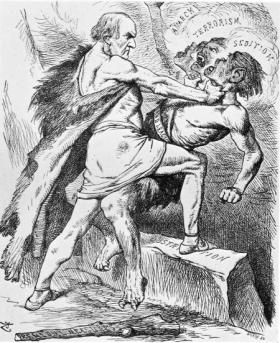
‘Strangling the Monster’—Gladstone gets to grips with ‘anarchy’, ‘terrorism’ and ‘sedition’ in Ireland. (Punch, 5 February 1881)
After the Phoenix Park murders in May 1882, Gladstone introduced a stringent crimes act and created at Dublin Castle what was intended to be a permanent secret service department: the Crime Special Branch, led by an ‘Assistant Under-Secretary for Police and Crime’. From July 1882 until January 1887 this position was occupied by Edward George Jenkinson (1835–1919), a former governor in India. His responsibility was to cooperate with all members of the British cabinet as well as the leaders of the army, and to coordinate the intelligence work of the semi-military Royal Irish Constabulary (RIC), the unarmed Dublin Metropolitan Police (DMP) and, finally, the new special resident magistrates and auxiliary police forces (an experiment first tried in 1881, not in 1920) created by Gladstone to augment the existing resident magistrate system of justice and policing in Ireland. Six folders of Jenkinson’s correspondence with Earl Spencer (president of the Irish privy council in 1880–2 and 1886, and lord lieutenant of Ireland in 1882–5) are held in the Althorp Papers, British Library, London (Add. 77031–37).
Policing the Land War and the Fenians
The predominant feature of this correspondence was a fear that Ireland could very easily return to the political situation of 1881, when the British government faced a serious outbreak of sedition and the threat of anarchy. Agrarian unrest in Ireland was equated with dangerous radical democratic activity and the existence of the IRB. Jenkinson received a secret service fund from the chief secretary, separate from the RIC and DMP. From this fund he spent £35,693 between July 1882 and March 1885. Securing convictions against IRB activists was deemed essential. For example, on 18 October 1883 Jenkinson cited six ‘land war’ trials taking place in the west of Ireland, claiming that ‘the future condition of all the counties in the West depends upon the results of the trials in these cases’, and that it ‘will be most disastrous’ if IRB leaders on trial, such as J. P. McCarthy of Loughrea, Co. Galway, and P. W. Nally of Balla, Co. Mayo, were not convicted. Therefore, ‘there must be perfect co-operation between the lawyers and the crime investigation department . . . if we had not so acted in the Phoenix Park murder case, we should not have been nearly so successful, and these cases in the West are in their way just as important as that case’. On 15 January 1884 he reported that £2,725 was spent recently as rewards to men who agreed to give evidence for the crown prosecutors (a further £6,500 was spent on general information). On Jenkinson’s advice, some trials, such as that of P. W. Nally (‘Nally has great influence and Carrick would hardly be safe’), were relocated to places where sympathetic juries could be found so that the crown prosecutors’ case would be stronger.
These tactics were seen less as a means of containing the threat of agrarian anarchy than as a way to defeat the IRB. For instance, on 31 October 1883 Jenkinson noted with regard to leading IRB ‘organisers like P. N. Fitzgerald [its chief travelling organiser] and John O’Connor [its secretary/president], who are now going about organising and appointing officers’, that ‘we shall have to tackle the scoundrels before long in a much more summary manner than under the existing law is now possible. We cannot afford to wait . . . It is impossible to get legal proof . . . Your Excellency may have opportunities for drawing [the] attention [of the cabinet] to the subject while you are in London.’ Subsequent correspondence indicates that the cabinet agreed with this judgement, while on 4 January 1884 Jenkinson wrote that Gladstone had persuaded the queen ‘to offer me a C.B. ship “in recognition of the valuable services which I have rendered in Ireland connected with the detection of crime”’.
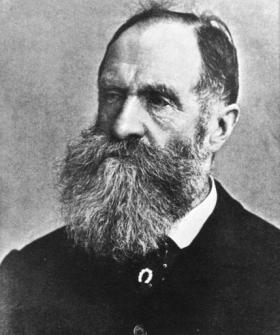
The lord lieutenant, Earl Spencer.
Securing convictions by whatever means, in conjunction with the constant shadowing of suspects, was seen as a means of breaking up the IRB through spreading debilitating fear. For instance, on 3 April 1884 Jenkinson reported gladly that the convictions of Nally and others (on false evidence) ‘have fallen heavily on the Fenian party . . . Fitzgerald and others say they are too closely watched—and they, none of them, now feel safe. Here at any rate is one good result, even though it be only temporary.’ The same day, a series of arrests were ordered in Sligo, but ‘there is not such much [evidence] on P. N. Fitzgerald as I hoped to find’. Four days later, however, ‘on the attorney general’s opinion’, his arrest was ordered purely on the grounds that ‘his arrest just now will be a tremendous blow to the Fenians’. Together with his deputy, Major Nicholas Gosselin, Jenkinson spent three days without sleep engaging in ‘a tremendous hunt after P. N. Fitzgerald’, who was not easy to track down (‘if it had not been for private information I got at two o’clock on Thursday morning, he would have got over to France’), and in putting into operation a ‘very secret’ plot, about which he had written a memorandum for Gladstone ‘showing exactly how it stands’. This plot was to plant bombs on John Daly (Fitzgerald’s predecessor as IRB chief travelling organiser, who had recently come back from America) and thereafter secure his arrest. Its purpose was partly to embarrass the American government (‘it will be great to “fix” the men: to show they came from, and are in, America . . . the American government . . . will have to get out of the mess as best as they can’) but mostly it was intended to undermine the IRB. On 12 April Jenkinson reported on his success in framing Daly and in capturing Fitzgerald, and noted that ‘these two arrests coming together will cause great consternation in the enemy’s ranks’. The arrest of Fitzgerald, in particular, ‘had a great effect’: ‘it has spread consternation everywhere. All [IRB] meetings have been stopped . . . [the home secretary] is tremendously pleased.’ Securing convictions was the next task.
While Daly and his associate James Egan were sentenced to life imprisonment on false evidence in August 1884, Fitzgerald was kept in police custody at Sligo jail for six months as Dublin Castle attempted to build a case against him. Together with the home secretary, Jenkinson initially wanted the attorney general to lead the prosecution against Fitzgerald (‘the crown solicitor is hardly a big enough man for the case’) and advised that ‘counsel should be employed as was done in the Phoenix Park Murder case, and as they are now doing in England in Daly and Egan’s case’. Through a prisoner-informer, Patrick Delaney, various bits of information were found, including papers of a prominent Galway Fenian, Matthew Harris. By September 1884, however, Jenkinson (who had to stay in London for most of that year) was much frustrated by the fact that, despite his constant appeals, ‘the case has not been well worked up’ by the authorities in Dublin. In November 1884, being very angry to hear that Fitzgerald was acquitted in a Dublin court, Jenkinson surmised that ‘we must do our best to neutralise the harm’ through recruiting agents within the IRB to watch and subtly counteract every plan such figures might have. This was not too difficult to do, not least owing to the effects of British infiltration of Clan na Gael, the Irish-American filibuster organisation.
Apart from his Irish duties paid by the chief secretary, Jenkinson was also paid by the secretary of state for ‘the cost of my agents in America and Paris’, and his correspondence from June to August 1883 indicates that this work involved not only agents provocateurs (which soon became a widely known fact) but also an Irish-American double agent. Pointless but terrifying Irish-American bomb scares prompted many Irish people in Britain, including some senior IRB figures in Liverpool, Manchester, Leeds, Glasgow and London, to cooperate with the police to uproot these conspiracies, which (probably unknown to such individuals) invariably originated with British agents provocateurs. Reports from September 1884 to March 1885 also indicate that the IRB leader for northern England, a Preston publican named William McGuinness, almost certainly consented to enter Jenkinson’s pay and thereafter began to express some moral approval for the ‘dynamite war’ (he ceased to do so when
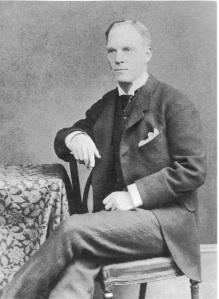
Edward George Jenkinson, Assistant Under-Secretary for Police and Crime from July 1882 to January 1887, nicknamed the ‘spy-master general’ by the British cabinet.
John O’Connor threatened him with expulsion from the IRB). In addition, two IRB leaders up until 1882 were now at least willing (perhaps only temporarily) to enter into communication with the police, namely Robert Johnston of Belfast (who, probably owing to social tensions in Belfast, was prepared to alert the police if he heard of dynamite plots) and Mark Ryan of London. As a result of its hold on the IRB in Britain, the Special Branch was able to learn what was discussed at a few supreme council meetings from July 1884 until at least Jenkinson’s retirement in January 1887, while the general degree of infiltration ensured that the IRB could never find out how British intelligence had acquired the upper hand.
‘A means to an end’: the Special Branch and the Home Rule question
The British government’s concerted campaign to hunt and destroy the Irish nationalist underground at this time was not motivated by an actual fear of its military capacity: Dublin Castle had a standing army of 20,000 men and a military-trained police force of 10,000 men permanently at its disposal. Instead, its great fear was that the IRB, which still had well over 30,000 members, would press a seditious political stance on the Irish National League, whose ordinary members were often seen to be more sympathetic to the ‘Fenians’ than to the Irish Parliamentary Party. This could create a potent revolutionary flank that could not easily be broken—the aim of the revolutionaries’ ‘new departure’ proposals. Making sure that such an alliance could never come about was essential, particularly before the envisioned enfranchisement of half of all adult males in December 1884.
A Special Branch memorandum to the cabinet from around this time emphasised the point that ‘Ireland is passing through a revolution, and what we have to try to do is to guide her through that revolution without the shedding of blood, and without injury to certain classes’. After Daly and Fitzgerald’s arrest in April 1884, Jenkinson emphasised that ‘the vigorous administration of the present exceptional laws are necessary now, but only as a means to an end. We cannot always go on . . . keeping the people down by force.’ Instead, ‘we must, before a year is out, adopt measures for strengthening our criminal administration; and for giving us a stronger grip on the country . . . Your Excellency knows in what direction my opinions incline.’ By this he meant making some political gesture in the direction of Home Rule, something that no cabinet member was yet even willing to contemplate but which Jenkinson persuaded Spencer to consider from April 1884 onwards.
On 18 April, claiming that ‘I am a Home Ruler at heart’, Jenkinson expressed admiration for Parnell’s speech at Drogheda six days earlier, and advised Spencer to read an article in the Fortnightly Review (1 April 1884) calling for an ‘Anglo-Roman Alliance’. This was written by Fr W. M. Brady, a Dublin-born priest working in Rome as private chaplain to Pope Leo XIII. Fr Brady maintained that, now that the papal states no longer exercised political power, Britain had no reason to be opposed to opening diplomatic relations with the Vatican, or to fear meeting the demands of the Irish Catholic hierarchy and Irish Party for promoting Catholic education, as neither the church nor the Irish Party wanted Irish independence, while Irish-born Catholics had proved themselves completely loyal servants to the British Empire all the world over: only the Fenian, or ex-Land League, revolutionaries presented a problem. Jenkinson knew many Irish Party members personally (as MPs, legally they could not avoid talking to him, if he so desired) and, commenting on Fr Brady’s arguments, he noted that ‘there is a great deal in it’.
In September and October 1884, as the franchise extension bill was being introduced into parliament, Parnell gave the Catholic hierarchy effective powers of veto over the policies of the Irish National League and the choice of Irish Party candidates, very probably to prevent the IRB from ever exerting an influence over the former. Meanwhile, Jenkinson advised that as the public are so ‘easily led’ to believe anything, ‘however untrue it may be’, it would be a good idea for Gladstone sometime in the near future to ‘boldly avow the principle of Home Rule’, but ‘I would not grant it’. Writing to Spencer, he noted that ‘if Your Excellency can only persuade the other members of the cabinet to agree with the view, a great step will have been gained’:
‘None of the nationalists know what our intentions are, and to what end we are working . . . [to] create disunion among the nationalist leaders . . . [so] sensible ones among them would come over to our side . . . Make the Irish believe that we look forward to a different and better system of government in the future.’
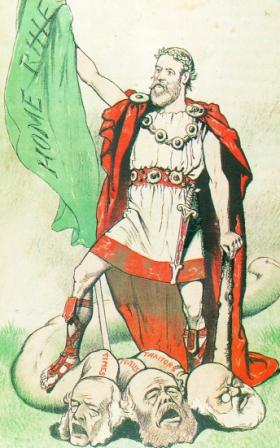
Nationalist cartoon depicting an all-conquering Parnell.
By August 1885 Jenkinson was able to inform Spencer that, apart from several members of the cabinet, he had already got leaders of the Tory Party (sitting in opposition) to accept his security policy: ‘Lord Carnarvon [then in private debate with Parnell and Sir C. G. Duffy] thoroughly understands the question now . . . I have given him a memorandum containing my proposals. He, Lord Ashbourne, Sir R. Hamilton are with me so, I hope, everything is settled this month.’ One more issue needed to be dealt with, however. In December 1885, by which time he was also acting as a direct adviser to Gladstone, Jenkinson advised Spencer that since the threat of separation ‘lies at the root of the whole matter’, and as ‘we also know that the Roman Catholic Church is in favour of the Union, and is against separation’, ‘I think it be a wise thing to draw closer to that church, and to put ourselves in communication with such men as the two Archbishops I have named [Walsh and Croke] . . . I attach great importance to the share which the Roman Catholic Church will take in the solution of the Irish question and to the great influence which it will exercise.’ The following month, Jenkinson reported that he had met and convinced Cardinal Manning of London, the leader of the Catholic Church in Britain, to support his plan, and so now ‘we may reckon the strong support of the R.C. clergy in Ireland’ in assisting in British security matters: a state-enforced responsibility that the Catholic Church may not have entirely liked, yet could not, under the Union, avoid. Days later, Gladstone’s ‘Home Rule conversion’ was announced to the world, while the entire Irish Catholic hierarchy issued a statement in early February expressing, for the first time, their support for the (as yet undefined) concept of ‘Home Rule’.
During the summer of 1886, as the Irish Party’s press raved about Gladstone’s strange and essentially unworkable bill (which was defeated), Jenkinson reported to the cabinet that the most significant Irish political development of recent times was that ‘the IRB can hardly be said to exist at the present time, as an organisation. It is true that there has been no decrease in the number of members… but there is no real discipline or settled line of action . . . [they are] afraid to attend to their duties’, owing to their awareness that British intelligence had somehow acquired the upper hand. It was believed that the movement was now sure to disintegrate, as indeed it largely did over the next decade: by the mid-1890s Gosselin was reporting that the IRB was ‘just a shadow of a once terrifying name’.
Following his retirement in January 1887, Jenkinson was knighted by the queen and continued to correspond with Spencer, albeit less frequently, about political matters. He was bemused by the false Tory propaganda campaign against Parnell for accepting American financial support (‘there is great misconception about the funds supplied to the Irish Party’), and remained a great admirer of the Irish Party leader. A week after Parnell’s death in October 1891, Jenkinson wrote that ‘he was a great and remarkable man’, and though ‘he was foolish, mad I should say, the last year of his life [when he looked for the Fenians’ support] and did harm to the cause for which he had done so much’, overall he ‘did wonders for Ireland’. In the same letter, Jenkinson noted how he had intended running for parliament himself as a Home Rule candidate, so that he could finally receive some public credit for having brought the idea centre stage, but he was dissuaded from doing so.
Conclusion
The importance of the first Home Rule bill of 1886 has always been emphasised greatly in writing on the Irish question in British history from the 1880s up until partition in 1920 and beyond, with the introduction of devolution across the United Kingdom (including Northern Ireland) in 1998. In the writing of Irish history, however, its significance has yet to be analysed rationally. Devolution in Ireland could never make legal sense unless devolution was introduced across the whole United Kingdom, and the Jenkinson–Spencer correspondence shows that the British government’s only purpose in introducing the idea of devolution into Irish public debate in 1886 was to contain the Irish situation. Security was then the major and decisive element in framing the British government’s policy for Ireland, and the Crime Special Branch evidently instigated the first Home Rule episode with the full cooperation of both the Tories and the Liberals, and seemingly with the full knowledge of the Irish Party (or at least Parnell and the Catholic hierarchy) as well, purely as a security ruse—and, of course, without the knowledge of the general Irish public. It is important that Irish historians begin to recognise this, as it shows that contemporary British political leaders were acting for motives directly opposite to those of the general Irish public, who took their lead from Parnell’s party. It shows how unreliable contemporary Irish newspapers and party political debates are as a historical source for the high political realities of the time.
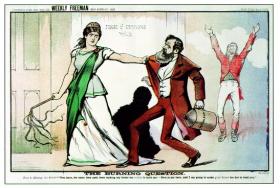
Erin, whip in hand, about to chastise the chief secretary for Ireland. Cartoons such as this (and the one on the previous page) tended to bolster the impression presented to the Irish public by the Irish Parliamentary Party that it had power over the British government, when the reverse was the case. (Weekly Freeman, 29 January 1887)
Owen McGee is a historian from Greystones, Co. Wicklow.
Further reading:
D. G. Boyce (ed.), The revolution in Ireland 1879–1923 (London, 1989).
E. Larkin, The Roman Catholic Church and the making of the Irish state, 1878–1886 (Dublin, 1975).
O. McGee, The IRB (Dublin, 2005).
















